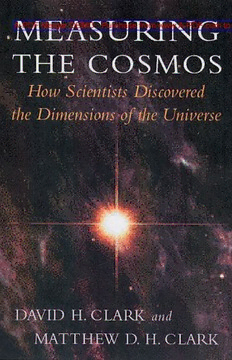
Measuring the cosmos : how scientists discovered the dimensions of the universe PDF
Preview Measuring the cosmos : how scientists discovered the dimensions of the universe
A-PDF Merger DEMO : Purchase from www.A-PDF.com to remove the watermark 00-R2958-FM 3/26/04 8:50 AM Page i MEASURING THE COSMOS G&S Typesetters PDF proof 00-R2958-FM 3/26/04 8:50AM Pageii PREVIOUS BOOKS BY DAVID H. CLARK The Historical Supernovae(with F. R. Stephenson) Applications of Historical Astronomical Records (with F. R. Stephenson) Superstars The Quest for SS433 The Cosmos from Space Aliens: The Search for Extraterrestrial Intelligence (with Andrew J. H. Clark) Newton’s Tyranny(with Stephen P. H. Clark) G&S Typesetters PDF proof 00-R2958-FM 3/26/04 8:50AM Pageiii MEASURING THE COSMOS How Scientists Discovered the Dimensions of the Universe DAVID H. CLARK and MATTHEW D. H. CLARK RUTGERS UNIVERSITY PRESS New Brunswick, New Jersey, and London G&S Typesetters PDF proof 00-R2958-FM 3/26/04 8:50 AM Page iv Library of Congress Cataloging-in-Publication Data Measuring the cosmos : how scientists discovered the dimensions of the universe / David H. Clark and Matthew D.H. Clark. p. cm. Includes bibliographical references and index. ISBN 0-8135-3404-6 (hardcover : alk. paper) 1. Cosmology—Research. I. Clark, David H. II. Clark, Matthew D. H., 1970– QB981.M385 2004 523.1—dc22 2003020096 A British Cataloging-in-Publication record for this book is available from the British Library. Copyright © 2004 by David H. Clark and Matthew D. H. Clark All rights reserved No part of this book may be reproduced or utilized in any form or by any means, electronic or mechanical, or by any information storage and retrieval system, without written permission from the publisher. Please contact Rutgers University Press, 100 Joyce Kilmer Avenue, Piscataway, NJ 08854–8099. The only exception to this prohibition is “fair use” as defined by U.S. copyright law. Manufactured in the United States of America G&S Typesetters PDF proof 00-R2958-FM 3/26/04 8:50 AM Page v To David Samuel, Marcus Alexander, and Peter James G&S Typesetters PDF proof 00-R2958-FM 3/26/04 8:50 AM Page vi G&S Typesetters PDF proof 00-R2958-FM 3/26/04 8:50AM Pagevii CONTENTS Preface and Acknowledgments ix Prologue A Rapid Journey through Time and Space 1 Chapter 1 Ingenious Visions 9 Chapter 2 Serious Measurements 36 Chapter 3 The Great Debate 62 Chapter 4 Seeing Red 91 Chapter 5 The Nature of Creation 123 Chapter 6 Living with Inflation 156 Glossary 183 Bibliography 195 Index 197 G&S Typesetters PDF proof 00-R2958-FM 3/26/04 8:50AM Pageviii G&S Typesetters PDF proof 00-R2958-FM 3/26/04 8:50 AM Page ix PREFACE AND ACKNOWLEDGMENTS This book tells the stories of “heroes” and “heroines,” both well known and unsung, behind the present understanding of the ori- gin, size, and age of the cosmos. Edwin Hubble, Albert Einstein, Fred Hoyle—these are household names. But how many people, other than professional astronomers, have heard of scientists like Heber Curtis, Henrietta Swan Leavitt, Annie Jump Cannon, Mil- ton Humason, or Vesto Slipher? Our current understanding of the nature of the universe depends on all of them, not just the fa- mous few. Nor was the path to contemporary knowledge a well-ordered progression from ignorance to understanding. Along the way, astronomers, mathematicians, and physicists made mistakes, faced impenetrable uncertainties, and found plenty of time to fight within their ranks. The stories of the scientists involved in measur- ing the cosmos reveal ambitions, conflicts, failures, as well as suc- cesses as the astonishing scale and age of the universe were finally established. Few areas of scientific research have witnessed the likes of the clashes of egos, the claims and counterclaims of priority of thought, or the failed (or falsified) theories and observations that resultedfromattemptstomeasuretheuniverse.TheancientGreeks used the word cosmos to describe the observable heavens. The word cosmos means order and hierarchy (and is the opposite of chaos). Not only the universe, but also the emergence of a true un- derstanding of its complexity, would prove to be more chaotic than the Greek scholars could ever have imagined for a system they be- lieved to be perfect and well ordered. ix G&S Typesetters PDF proof
